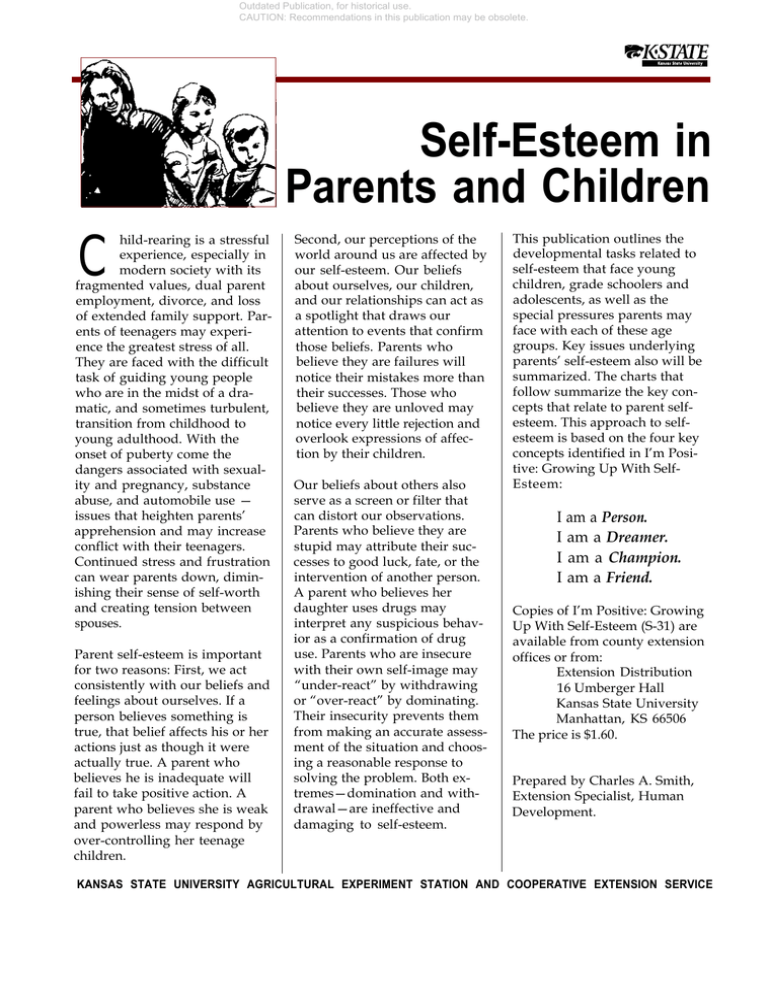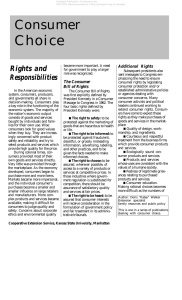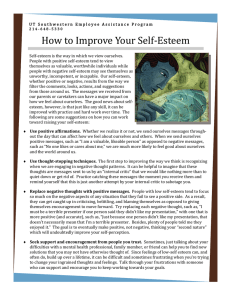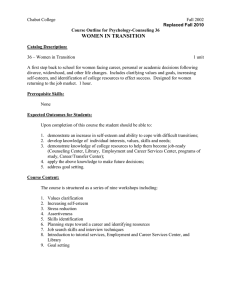
Outdated Publication, for historical use.
CAUTION: Recommendations in this publication may be obsolete.
Self-Esteem in
Parents and Children
C
hild-rearing is a stressful
experience, especially in
modern society with its
fragmented values, dual parent
employment, divorce, and loss
of extended family support. Parents of teenagers may experience the greatest stress of all.
They are faced with the difficult
task of guiding young people
who are in the midst of a dramatic, and sometimes turbulent,
transition from childhood to
young adulthood. With the
onset of puberty come the
dangers associated with sexuality and pregnancy, substance
abuse, and automobile use —
issues that heighten parents’
apprehension and may increase
conflict with their teenagers.
Continued stress and frustration
can wear parents down, diminishing their sense of self-worth
and creating tension between
spouses.
Parent self-esteem is important
for two reasons: First, we act
consistently with our beliefs and
feelings about ourselves. If a
person believes something is
true, that belief affects his or her
actions just as though it were
actually true. A parent who
believes he is inadequate will
fail to take positive action. A
parent who believes she is weak
and powerless may respond by
over-controlling her teenage
children.
Second, our perceptions of the
world around us are affected by
our self-esteem. Our beliefs
about ourselves, our children,
and our relationships can act as
a spotlight that draws our
attention to events that confirm
those beliefs. Parents who
believe they are failures will
notice their mistakes more than
their successes. Those who
believe they are unloved may
notice every little rejection and
overlook expressions of affection by their children.
Our beliefs about others also
serve as a screen or filter that
can distort our observations.
Parents who believe they are
stupid may attribute their successes to good luck, fate, or the
intervention of another person.
A parent who believes her
daughter uses drugs may
interpret any suspicious behavior as a confirmation of drug
use. Parents who are insecure
with their own self-image may
“under-react” by withdrawing
or “over-react” by dominating.
Their insecurity prevents them
from making an accurate assessment of the situation and choosing a reasonable response to
solving the problem. Both extremes—domination and withdrawal—are ineffective and
damaging to self-esteem.
This publication outlines the
developmental tasks related to
self-esteem that face young
children, grade schoolers and
adolescents, as well as the
special pressures parents may
face with each of these age
groups. Key issues underlying
parents’ self-esteem also will be
summarized. The charts that
follow summarize the key concepts that relate to parent selfesteem. This approach to selfesteem is based on the four key
concepts identified in I’m Positive: Growing Up With SelfEsteem:
I am a Person.
I am a Dreamer.
I am a Champion.
I am a Friend.
Copies of I’m Positive: Growing
Up With Self-Esteem (S-31) are
available from county extension
offices or from:
Extension Distribution
16 Umberger Hall
Kansas State University
Manhattan, KS 66506
The price is $1.60.
Prepared by Charles A. Smith,
Extension Specialist, Human
Development.
KANSAS STATE UNIVERSITY AGRICULTURAL EXPERIMENT STATION AND COOPERATIVE EXTENSION SERVICE
Outdated Publication, for historical use.
CAUTION: Recommendations in this publication may be obsolete.
Self-esteem tasks for children
Early childhood:
Ages birth—6
Person
Dreamer
Champion
Friend
Middle childhood:
Ages 7—12
Adolescence:
Ages 13—18
Gains familiarity with the
objective, observable, physical dimensions of self.
Differentiates self from
others. Begins to form
opinions about the self. Recognizes whether he or she is
special to parents.
Expands the physical/
behavioral concept of self to
include psychological or
personality characteristics.
Compares self with others
and evaluates self in terms of
others’ impressions. Shift in
focus from family to friends
in defining the self.
Adjusts to dramatic physical
changes. Establishes independence from family and
peers. Experiments with
different identity forms.
Comes to terms with his or
her individuality. More
aware of strengths and
weaknesses.
Works toward immediate
goals (building a tower of
blocks, making a painting).
Develops imagination—the
ability to envision possibilities. Develops a positive or
negative attitude toward a
general, non-specific future.
(Tells mother, “When I grow
up I’m going to marry you!”)
Begins to have a clearer
picture of possible life goals.
Likely to respond to “What
do you think you want to be
when you grow up?” Learns
to work toward short-range
goals (e.g., school projects).
Becomes more aware of his
or her talents; acquires
hobbies.
Life goals become more
important. May feel insecure
about the future at times.
Forms a clearer picture of
realistic occupational choices.
Seeks a match between
interests and strengths and
career alternatives.
Takes pride in making things
happen rather than creating
products (loves painting,
building, and running more
than the end results). Discovers what the body is capable
of. Perseveres in moderately
difficult tasks. Resists physical assault by peers; protects
property. Occasionally resists
demands of parents.
Competition may have a
significant effect on selfworth. Takes pride in accomplishments. Learns strategies
for resisting psychological
assault. Acceptance by peers
nurtures sense of competence. Emulates attractive
same-sex role model. Uses
power to cooperate with and
help others.
Integrates strong feelings
about right and wrong into
an ethical framework.
Perseveres toward important
goals despite ridicule or
doubt. Will not be distracted
by others’ self-destructive
behavior. Capable of negotiating conflict.
Learns skills for social
interaction with peers. Gives
and receives physical affection in relationships with
parents and special friends.
Begins to form a conscience.
Responds to others’ distress
in a positive manner. Shows
tenderness toward pets,
assumes some responsibility
for their care.
Forms closer, more enduring
friendships. Has a “best
friend.” Learns the give and
take necessary for lasting
friendships. Participates in a
peer culture. Conscience
becomes a significant part of
the personality.
Can understand and respond
to psychological distress.
Provides psychological
support to peers experienc–
ing distress. Frames problems from another person’s
viewpoint. Relates success–
fully to the opposite sex.
Note: Ages are approximate. Adolescence may be considered to begin at onset of puberty.
Outdated Publication, for historical use.
CAUTION: Recommendations in this publication may be obsolete.
Developmental pressures on parents’ self-esteem
Early childhood
Middle childhood
Concern about their children’s
vulnerability.
Apprehension over erosion of
influence and gradual loss of control
to their children’s peer group.
Conflict between their personal
goals (career and leisure time) and
their children’s needs.
Conflict with their parents and inlaws about child-rearing.
Constant demands for making adjustments in their expectations as
their children grow and change.
Marital strain because of new
child-rearing demands.
Greater psychological fatigue from
constant demands on time and
attention from dependent young
children.
Greater physical fatigue because of
the work required for child care.
Conflict with children who are
egocentric and selfish.
Changes in self-image from the
child of one’s parents to the parent
of one’s children.
Concern about their children’s
school performance and study
habits.
Additional time demands from
children’s increased participation in
school and community activities.
Difficulty in recognizing and accepting their children’s true limitations;
adjusting their own aspirations
while coming to terms with their
children’s capabilities.
Concern about their children’s
feelings of inadequacy, inferiority.
Apprehension about children’s
greater independence and loss of
parental control; no longer able to
protect and guide them. Increased
mobility and time spent away from
home means greater exposure to
outside threats.
Adolescence
Conflict between their values and
beliefs and those of their children.
Dramatic changes in young people’s
intellectual development make differences of opinion and conflict
more likely.
Coping with strong emotions and
tensions associated with adolescent
insecurity and self-consciousness.
Pressure from increasing financial
demands.
Rejection by children as they prepare to leave the security of their
parents’ home for life on their own.
Difficulty in helping children make
positive career choices.
Outdated Publication, for historical use.
CAUTION: Recommendations in this publication may be obsolete.
Parent self-esteem
Person
Dreamer
You are a person in your own right. Separate your sense of self from that of your children. Regardless of our devotion and attachment to our children, we are still unique individuals with our own needs. Keeping our sense of self separate from our children is not rejection,
abandonment, or neglect. If we grant ourselves the right to be individuals we can also give our
children the freedom to define themselves—to dream their own dreams and fight their own
battles. We have a life outside of being a parent, with our own friendships and interests.
Self-acceptance promotes self-respect. Remember that you are only human, and learn
from your mistakes. To paraphrase Dorothy Briggs, “Look forward, to your stars, not backward, to your scars.” We do not have to define ourselves by our children’s successes and
failures, either. We need to view ourselves as good people regardless of the choices our children make.
Nurture your own dreams as well as your children’s. What do you hope to accomplish
with your life? Focus on some personally satisfying activity that gives you a feeling of accomplishment. Setting personal goals nurtures hope and a positive view of the future.
Be reasonable in your expectations for yourself as well as for your children. Unreasonable expectations and irrational distortions lead to failure, aggravate stress and diminish selfesteem. Avoid the role of the all-knowing, all-powerful, “always right” parent. Re-examine
your attitude toward time: take a long-term view of your own life and your children's.
Champion
Live up to your convictions. Do not feel swept along by shifting social values, personal
fatigue, time pressures and harassment from children or other relatives. Define what is important for you and your children and use those convictions to guide your actions. Parents are not
helpless: We have the power to make choices about how to raise our children. We may be
challenged to rise above the hurtful child-rearing we experienced as children, and make our
own choices. If we were spanked by our parents we are not destined to spank our children. If
we heard hurtful words we are not destined to repeat them to our children. We can define for
ourselves the kind of parents we want to be.
Friend
Make a conscious choice to love and nurture your children. Being a parent can stretch
and deepen all of our emotions—joy, love, anger, fear, sadness. The struggle of protecting and
nurturing another human life can deepen our humanity and compassion.
To love and nurture our children we must also love and nurture ourselves. When there is
a conflict, who comes first? When a crisis occurs with our children, we may drop everything,
forgetting ourselves and providing immediate, unconditional support by giving our time and
resources to restore our children’s well-being. Never lose sight, though, of your own need for
support and affection. Find linkages with other caring adults who can meet these emotional
needs.
Contents of this publication may be freely reproduced for educational purposes. All other rights reserved. In each case, credit Charles A. Smith,
Self-Esteem in Parents and Children, Kansas State University, March 1990.
MF-955
March 1990
Kansas State University Agricultural Experiment Station and Cooperative Extension Service
It is the policy of Kansas State University Agricultural Experiment Station and Cooperative Extension Service that all persons shall have equal
opportunity and access to its educational programs, services, activities, and materials without regard to race, color, religion, national origin, sex,
age or disability. Kansas State University is an equal opportunity organization. Issued in furtherance of Cooperative Extension Work, Acts of
May 8 and June 30, 1914, as amended. Kansas State University, County Extension Councils, Extension Districts, and United States Department
of Agriculture Cooperating, Marc A. Johnson, Director.






